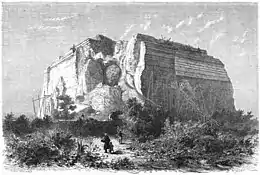 | |
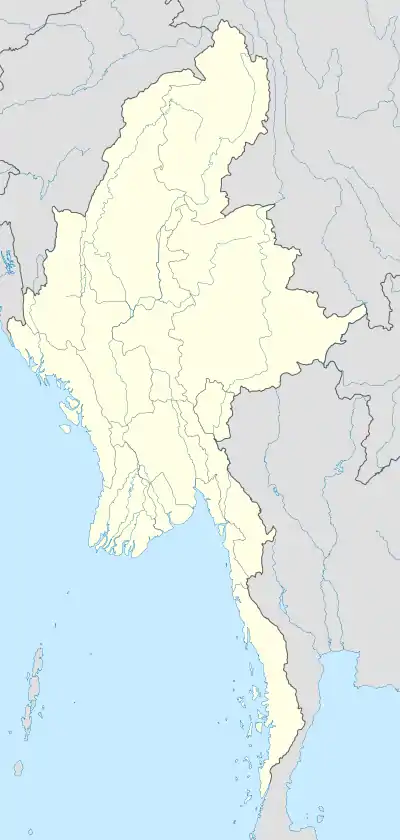 1839 Ava earthquake (Myanmar) | |
| UTC time | 1839-03-23 24:30 |
|---|---|
| Local date | 23 March 1839 |
| Local time | 04:00 |
| Magnitude | 7.4–8.3 Mw[1] |
| Epicenter | 21°54′N 96°00′E / 21.9°N 96.0°E |
| Fault | Sagaing Fault |
| Type | Strike-slip |
| Areas affected | Konbaung dynasty (present–day Myanmar) |
| Total damage | 3 cities destroyed |
| Max. intensity | XI (Extreme) |
| Foreshocks | Yes |
| Aftershocks | Yes |
| Casualties | 300–400 dead |
The 1839 Ava earthquake, also known as the Amarapura earthquake or Inwa earthquake, was a disastrous seismic event that struck central Burma on the morning of March 23.[2] This earthquake with a moment magnitude as high as 8.3, was one of the biggest in the country since 1762. Shaking reached XI (Extreme) on the Modified Mercalli intensity scale, and was felt in Rangoon and Bhamo.[3]
Tectonic setting
Burma is wedged between four tectonic plates; the Indian, Eurasian, Sunda and Burma plates that interact due to active geological processes. Along the west coast of the Coco Islands, off the Rahkine coast, and into Bangladesh, is a highly oblique convergent boundary known as the Sunda megathrust. This large fault marks the boundary between the Indian and Burma plates. The megathrust emerges from the seafloor in Bangladesh, where it runs parallel and east of the Chin Hills. This boundary continues to north of Burma where it ends at the eastern Himalayas.[4]
The Sagaing Fault is a mostly continental transform fault that runs through Burma and connects the Andaman spreading center to the collision zone in the north. It accommodates motion between the Burma and Sunda Plates as they slide past each other at a rate of 18 to 49 mm/yr. The fault runs the entire length of the country for over 1,200 km and continues its trace into the Andaman Sea. The Sagaing Fault is Burma's largest and most active source of seismic threat, running through or close to major cities like Yangon, Nay Pyi Daw and Mandalay. Several large and damaging earthquakes have occurred on this fault in historical times.[4]
Earthquake
The Sagaing Fault is a major transform boundary that runs through Myanmar, and is the source of the earthquake. The earthquake epicenter is presently located just outside the city of Mandalay. It is believed that the Meiktila and Sagaing segment of the fault ruptured during this earthquake for a length of 400 km (250 mi), generating an earthquake of magnitude 8.1–8.3 although further research is needed to confirm this.[5] The basis for this claim is the overall lack of seismic activity in the Meiktila segment which runs from Nay Pyi Taw to Mandalay, a length of about 260 km (160 mi). There is no official magnitude presented for this earthquake but most news media and research journals put the figure at 7.0–7.5 or ≥8.0 Mw .[6][7] Remote sensing and field observation revealed a maximum displacement of 5–7 m (16–23 ft) along the trace of the 1839 rupture just outside Mandalay. This would place the magnitude at 7.4–8.0+, and generate an earthquake rupture of at least 300 km (190 mi).[8][9]
In 1946 the 180 km (110 mi) long Sagaing segment produced two major earthquakes but there are no records of its impact. Ten years later, in 1956, a magnitude 7.1 earthquake struck close to the city of Mandalay, re-rupturing the 1839 rupture zone for about 60 km (37 mi).[10] Meanwhile, the 260 km long Meiktila segment has not experienced any major earthquake since 1839 and is considered a seismic gap.[5]
Damage and effects
The mainshock was preceded by a large foreshock in 1838 which also damaged the capital.[11] Great damage was reported in Inwa, so severe that the formal capital was moved to nearby Amarapura. In Mingun, a stupa sustained serious damage as a result of shaking. British officials in Myanmar recorded catastrophic damage and liquefaction in Mandalay and the surrounding area.[12][13] Many pagodas collapsed during the event. Chasms and fissures more than 10 ft (3.0 m) wide were seen in Amarapura and nearly every brick building was reduced to rubble. Some villages were swallowed up as a result of liquefaction.[13] By a contemporary British estimate 300–400 people were killed.[2] The shock also reversed the flow of the Irrawaddy River, where the currents became violent and overflowed its banks.[12] It was felt for thousands of miles away from the epicenter, as far as Dacca, Calcutta and Bangkok.[3]
Gallery
.jpg.webp) Large cracks in the incomplete Mingun Pahtodawgyi caused by the earthquake
Large cracks in the incomplete Mingun Pahtodawgyi caused by the earthquake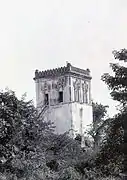 Nan Myint Tower slightly tilted due to ground effects from the tremor
Nan Myint Tower slightly tilted due to ground effects from the tremor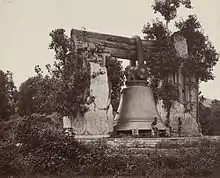 The Mingun Bell resting on the ground after losing its supports to the quake, pictured in 1873
The Mingun Bell resting on the ground after losing its supports to the quake, pictured in 1873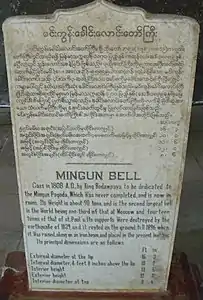 A plague that stands beside the Mingun Bell
A plague that stands beside the Mingun Bell The Hsinbyume Pagoda in 2014. Extensive restoration was done by Mindon Min in 1874 after the earthquake.
The Hsinbyume Pagoda in 2014. Extensive restoration was done by Mindon Min in 1874 after the earthquake.%252C_Mandalay_20.jpg.webp) The Maha Aungmye Bonzan Monastery after repair works
The Maha Aungmye Bonzan Monastery after repair works_Myanmar(Burma).jpg.webp) Preserved ruins from the ancient capital
Preserved ruins from the ancient capital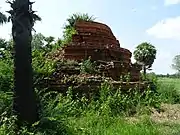 Overgrown ruins of a stupa
Overgrown ruins of a stupa
See also
References
- ↑ "Global Historical Earthquake Archive". emidius.eu. Global Historical Earthquake Archive. Retrieved 22 October 2021.
- 1 2 Oldham, Thomas. "A Catalogue of Indian Earthquakes from the earliest time to the end of AD 1869". Memoirs of the Geological Survey of India. XIX.
- 1 2 National Geophysical Data Center (1972). "Significant Earthquake Information". National Geophysical Data Center / World Data Service (NGDC/WDS): NCEI/WDS Global Significant Earthquake Database. NOAA National Centers for Environmental Information. doi:10.7289/V5TD9V7K.
- 1 2 Wang, Yu (2013). Earthquake Geology of Myanmar (Ph.D.). California Institute of Technology. doi:10.7907/XWW2-9P26.
- 1 2 Yu, Wang (2014). "Active Tectonics and Earthquake Potential of the Myanmar region". Journal of Geophysical Research: Solid Earth. 119 (4): 3767. Bibcode:2014JGRB..119.3767W. doi:10.1002/2013JB010762. hdl:10220/19774.
- ↑ Tapponnier, Paul; Kerry, Kerry (21 January 2010). "The Catastrophe in Haiti: A Repeat Lesson for Us all" (PDF). RSIS Commentaries. Nanyang Technological University. Retrieved 23 March 2021.
- ↑ Thant, Htoo (7 August 2019). "Govt unveils quake preparedness plan". Myanmar Times. Myanmar Times. Archived from the original on 24 June 2021. Retrieved 23 March 2021.
- ↑ Wang, Y.; Tapponnier, P.; Aung, T.; Tun, S. T.; Khaing, S. N.; Aung, L. T.; Sieh, K. (16 December 2014). "Morphotectonics of the Central Sagaing fault West of Mandalay: Trace of the 1839 Ava Earthquake Rupture". AGU Fall Meeting Abstracts. 2014. Bibcode:2014AGUFM.T24B..04W. Retrieved 23 March 2021.
- ↑ Xinhua (25 November 2009). "Myanmar setting up global positioning system for earthquake monitoring". People's Daily Online. People's Daily Online. Archived from the original on 22 March 2016. Retrieved 23 March 2021.
- ↑ Soe Thura Tun; Ian M. Watkinson (15 November 2017). "The Sagaing Fault, Myanmar". Geological Society, London, Memoirs. 48: 413–441. doi:10.1144/M48.19. S2CID 134291037. Retrieved 23 March 2021.
- ↑ "Significant Earthquake Information MYANMAR (BURMA): AVA (INNWA)". NGDC NCEI. Retrieved 23 March 2021.
- 1 2 "Some Documents of Tharrawaddy's Reign: 1837–1846, Part I". SOAS Bulletin of Burma Research. 1. 2003.
- 1 2 "Burmah". The Asiatic Journal. XXX. 1839.